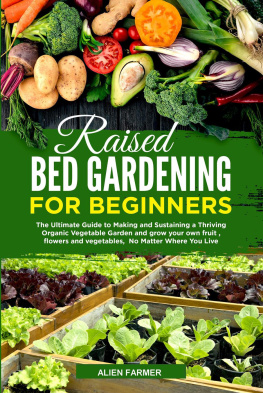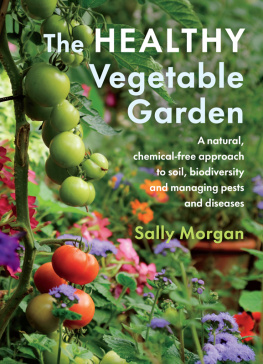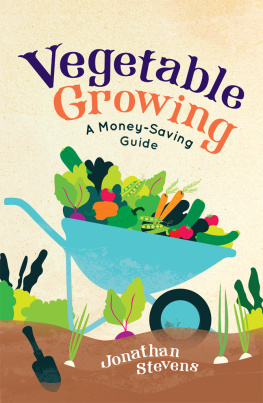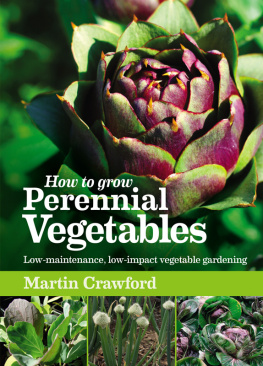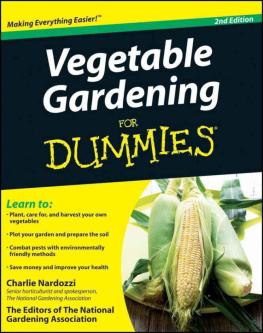Joy Larkcom - Grow Your Own Vegetables
Here you can read online Joy Larkcom - Grow Your Own Vegetables full text of the book (entire story) in english for free. Download pdf and epub, get meaning, cover and reviews about this ebook. year: 2013, publisher: MBI, genre: Children. Description of the work, (preface) as well as reviews are available. Best literature library LitArk.com created for fans of good reading and offers a wide selection of genres:
Romance novel
Science fiction
Adventure
Detective
Science
History
Home and family
Prose
Art
Politics
Computer
Non-fiction
Religion
Business
Children
Humor
Choose a favorite category and find really read worthwhile books. Enjoy immersion in the world of imagination, feel the emotions of the characters or learn something new for yourself, make an fascinating discovery.

- Book:Grow Your Own Vegetables
- Author:
- Publisher:MBI
- Genre:
- Year:2013
- Rating:3 / 5
- Favourites:Add to favourites
- Your mark:
- 60
- 1
- 2
- 3
- 4
- 5
Grow Your Own Vegetables: summary, description and annotation
We offer to read an annotation, description, summary or preface (depends on what the author of the book "Grow Your Own Vegetables" wrote himself). If you haven't found the necessary information about the book — write in the comments, we will try to find it.
This revised, updated and expanded edition Joy Larkcoms classic guide to growing your own vegetables contains everything you need to know to create a highly-productive vegetable plot. It covers every aspect of vegetable gardening, including preparing soil; manures, composts and fertilizers; growing techniques; protection; pests, diseases and weeds; and making good use of space.
The second half of the book provides cultivation information for over 100 vegetables, including site and soil requirements, cultivation, pests and diseases, and cultivars.
Grow Your Own Vegetables — read online for free the complete book (whole text) full work
Below is the text of the book, divided by pages. System saving the place of the last page read, allows you to conveniently read the book "Grow Your Own Vegetables" online for free, without having to search again every time where you left off. Put a bookmark, and you can go to the page where you finished reading at any time.
Font size:
Interval:
Bookmark:
JOY LARKCOM
ILLUSTRATIONS BY
ELIZABETH DOUGLASS
FRANCES LINCOLN LIMITED
To our dear granddaughter Jamila Celeste Aisla Rose
and with a special thank you to all my friends in the seed trade, who have given me so much help in thirty years of garden writing
GROW YOUR OWN VEGETABLES
Frances Lincoln Limited
4 Torriano Mews
Torriano Avenue
London NW5 2RZ
Copyright Frances Lincoln Limited 2002
Text copyright Joy Larkcom 2002
Edited by Anne Askwith
Designed by Jane Havell
Illustrations by Elizabeth Douglass
First Frances Lincoln edition: 2002
First published in hardback as Vegetables from Small Gardens, Faber & Faber, 1976
Revised and reprinted as paperback 1986
Revised paperback edition Vegetables for Small Gardens,
Hamlyn/Reed Consumer Books, 1995
All rights reserved. No part of this publication may be reproduced, stored in a retrieval system or transmitted, in any form, or by any means, electronic, mechanical, photocopying, recording or otherwise, without either prior permission in writing from the publishers or a licence permitting restricted copying. In the United Kingdom such licences are issued by the Copyright Licensing Agency, 90 Tottenham Court Road, London W1P
eBook conversion by Quayside Publishing Group
Digital Edition: 978-1-78101-134-8
Softcover Edition: 978-0-7112-1963-2
Little did I imagine when I started work on this books forerunner, Vegetables from Small Gardens, on my old typewriter back in 1974 that I would be revising it for the third time on a laptop computer in the twenty-first century. Many things have changed beyond recognition in the intervening thirty years and, for most of us, the pace of life has accelerated. Perhaps this, coupled with increasing anxieties about the safety and quality of so much of our food, lies behind the current revival of interest in growing vegetables. Seed companies are reporting higher sales of vegetable seeds than for many years, in many cases outstripping the sales of flower seeds.
This is an interesting parallel with what was happening in the mid-1970s, when a new generation was discovering the delights and satisfaction of growing their own vegetables. It is always hard to pinpoint what lies behind a trend, but it seemed then that the limited choice and poor flavour of shop vegetables, coupled with growing wariness of the chemicals used by commercial vegetable growers, were underlying reasons. Today there is indisputably a far wider choice of vegetables in shops and markets, and far more interest in using both ordinary and exotic vegetables. At the same time the number of vegetarians has risen dramatically, with many people, for various reasons, cutting down on the amount of meat in their diets and eating more fruit and vegetables. And just as it is no longer considered odd to be vegetarian, it is no longer odd to garden organically. In the shadow of global warming, we are learning, perhaps belatedly, the importance of caring for our environment, and that there is no better place to start than in our own gardens.
The first extensive revision of the book was in 1986, in the wake of a great deal of research into commercial vegetable growing. Much of this had a bearing on home gardening, throwing new scientific light on traditional practices and hunch. The new research told us precisely how spacing can be varied to get the size of vegetable we require, the stage in a plants cycle when it most pays to water and so on. Much of this work was undertaken in the UK at what was then the National Vegetable Research Station (now part of Horticulture Research International), and the material was relayed to the gardening public in the two volumes of Know and Grow Vegetables, subsequently republished in one volume as The Complete Know and Grow Vegetables. This book is fascinating reading for anyone interested in vegetable growing and I made extensive use of it in revising Vegetables from Small Gardens in 1986.
Another reason for updating then, and again in 1995, lay in the rapid changes in vegetable varieties available to gardeners. (Strictly speaking we should refer to varieties as cultivars the correct scientific term for varieties raised in cultivation but the term varieties lives on in popular parlance. In this book I use the terms synonymously.) Many excellent new cultivars were, and still are, being introduced by plant breeders but, at the same time, many old varieties were being withdrawn in Europe largely as a result of European Union legislation. While this has had some benefits, for example in clarifying the situation where one variety masqueraded under a dozen different names, it has meant that some old favourites, valued by home gardeners if not by commercial growers, have been withdrawn. And who knows what latent, potentially useful, genetic characteristics these old varieties may have. Fortunately organizations such as the Henry Doubleday Research Association in the UK and Seed Savers Exchange in the US have made it their business to collect and preserve old heritage varieties in seed libraries, making seed available to their members. They deserve our full support. Heritage varieties are often interesting and rewarding to grow, but I would also urge gardeners to make the most of the undeniable merits of many of the new cultivars.
A third reason for the 1986 revision was much more personal. Not long after Vegetables from Small Gardens was published, our family my husband Don Pollard and our children Brendan and Kirsten, then aged seven and five set off for a year on what we called the Grand Vegetable Tour. With a caravan as our home, we travelled around Europe in a southward arc from Holland to Hungary, visiting eight countries in all. Our purpose was to study traditional and modern methods of vegetable growing, and to collect the seed of old, local vegetable varieties which were in danger of dying out. We eventually sent over 100 samples to the national Vegetable Gene Bank at Wellesbourne, which was in the process of being established.
I learnt an enormous amount from that year of travel. Not only did we discover many new plants, for example summer and winter purslane, iceplant, salad rocket and the many beautiful red and related chicories, but we saw at first hand the traditional intensive methods of vegetable growing used on the Continent, now widely known under the umbrella term cut-and-come-again. These are explained fully later (see ), but in essence, they are used for growing wonderfully tasty salad seedlings which regenerate after the first, and sometimes after the second and third cutting. The same principle can be applied to mature crops, a fair number (including endives, oriental greens and cabbages) having the ability to regenerate even after the first main head has been harvested, so prolonging their useful life over many months. Combining these techniques with the traditional practice of spacing plants closely in narrow beds is a highly productive approach to gardening, and relevant to the modern gardener, for whom space is often at a premium.
When we returned from our tour we experimented with these new plants and methods in the small organic market garden we then established, finding much of what we had learnt particularly relevant to small gardens. These ideas were incorporated in the revised edition.
I should add here that while the earlier editions of this book were directed towards small gardens, in this edition the scope is broadened to make it useful for all gardeners. The emphasis is still on maximizing returns from whatever space is at your disposal after all, even if you have a large garden, the smaller the area devoted to vegetables, the easier it will be to manage. But this edition includes some of the larger, slower-growing and space-consuming vegetables that were previously omitted, such as large cauliflowers, pumpkins and other squashes, maincrop potatoes, orache and the colourful giant spinach
Font size:
Interval:
Bookmark:
Similar books «Grow Your Own Vegetables»
Look at similar books to Grow Your Own Vegetables. We have selected literature similar in name and meaning in the hope of providing readers with more options to find new, interesting, not yet read works.
Discussion, reviews of the book Grow Your Own Vegetables and just readers' own opinions. Leave your comments, write what you think about the work, its meaning or the main characters. Specify what exactly you liked and what you didn't like, and why you think so.

